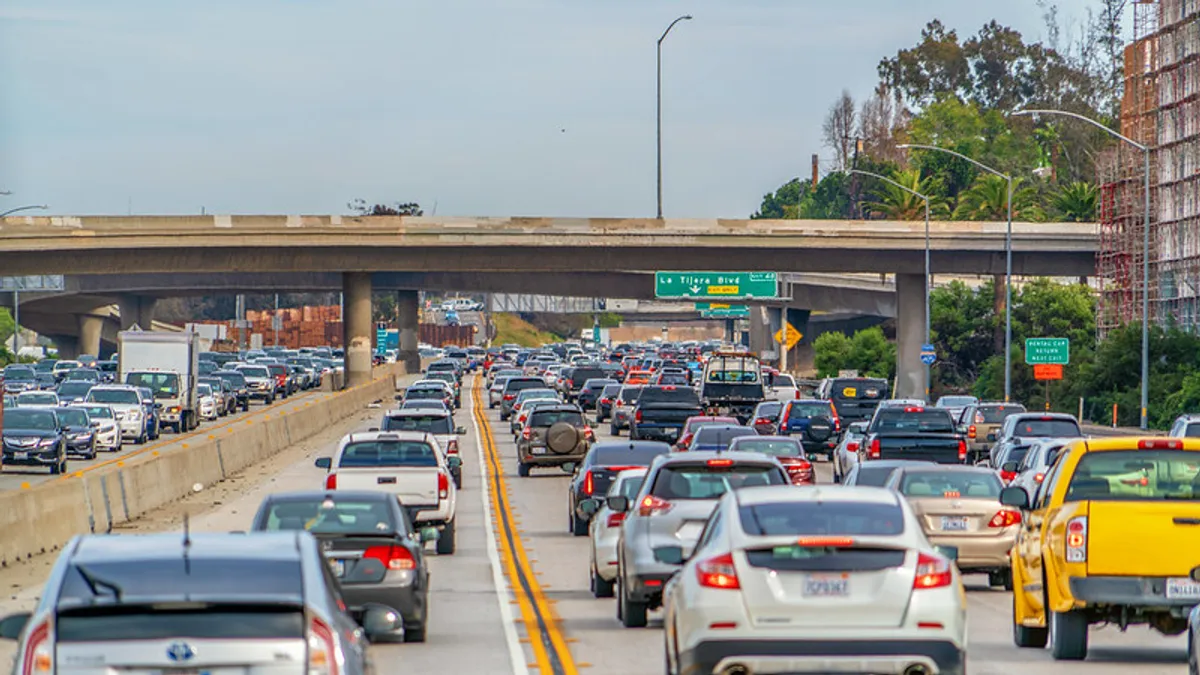Dive Brief:
- StreetLight Data has released its 2020 U.S. Transportation Climate Impact Index, which ranks the nation's 100 most populous metro areas on vehicle miles traveled (VMT), mileage of bike and pedestrian commuting, per-capita transit use, population density and circuity.
- The list's top regions are considered the most "carbon-friendly" or low-impact areas. The top five and bottom five metro regions of 2020 are:
| Top | Bottom |
|---|---|
| 1. New York-Newark, NJ-Jersey City, NJ | 96. Greensboro-High Point, NC |
| 2. North Port-Sarasota-Bradenton, FL | 97. Charlotte-Concord-Gastonia, NC-SC |
| 3. Portland-Vancouver-Hillsboro, OR-WA | 98. Nashville-Davidson-Murfreesboro-Franklin, TN |
| 4. Cape Coral-Fort Myers, FL | 99. Raleigh, NC |
| 5. San Francisco-Oakland-Hayward, CA | 100. Birmingham-Hoover, AL |
- The 2020 rankings widely differ from those in the 2019 index; only two metro regions — New York and San Francisco — ranked in both lists' "top 10." StreetLight Data recognized the COVID-19 pandemic has had an "unprecedented impact" on vehicle miles traveled (VMT) nationally, which in turn impacted the rankings. "It really remains to be seen if these changes are temporary," said Phaedra Hise, StreetLight Data's director of content, in an email to Smart Cities Dive.
Dive Insight:
VMT dropped to record lows in the country's major metros amid the COVID-19 pandemic, as governments implemented stay-at-home mandates and companies shifted to remote work policies. "Clearly some cities in 2020 had a lot less car driving than others," Hise said, yet it's too early to predict if cities will maintain their current VMT levels as communities slowly reopen.
A June 2020 Streetlight Data analysis found that even a 10% permanent reduction in VMT could drastically improve a city's climate. To help cities realize this potential, StreetLight even released an online calculator to "simplify the discussion" of VMT's impact on climate.
For the cities that found their way to the top of StreetLight's climate index amid the pandemic, their potential to maintain a low-carbon status will rely on continued VMT reduction. "Different cities get there in different ways," Hise said. "The key is to dig into the data and see what it tells you about your particular region, and where travel habits can be shifted."
Last year's record lows in VMT also uncovered a number of notable takeaways about the broader impacts of driving. One such takeaway identified by StreetLight is the misconception that driving and economic growth are connected.
"We were really excited to see this finding because it's been a long-held belief that the two are closely coupled, so that basically lots of traffic means a healthy economy," Hise said. "That sets up a fundamental struggle between climate advocates, who want less driving, and business leaders and elected officials, who want economic stability and growth."
Hise went on to say that decoupling VMT and gross domestic product (GDP) will require some work from governments to create climate incentives, such as California's recent legislation requiring construction projects to prove they will reduce traffic congestion. And while some revenue streams, like that of a gas tax, would drop with reduced VMT levels, so would the need for such revenue in the form of road maintenance.
"Shifting budgets, revenue and other resources is something we hope comprehensive transportation data can help policy makers figure out," Hise said.
Low VMT levels can come with risks, however. A December study from transportation analytics firm INRIX found low VMT levels were directly correlated to faster driving in the early months of the pandemic. The National Safety Council estimated the U.S. saw a 20% jump in motor vehicle fatalities from January to June 2020, the highest jump in a six-month period since 1999.
And as urban residents opt for active transportation like cycling over public transit, pedestrian and bicyclist safety will remain a priority for city leaders. Measures to improve safety don't need to be expensive or complicated, Hise said, as even a painted sharrow and added signage along a bike lane can keep a rider protected.












